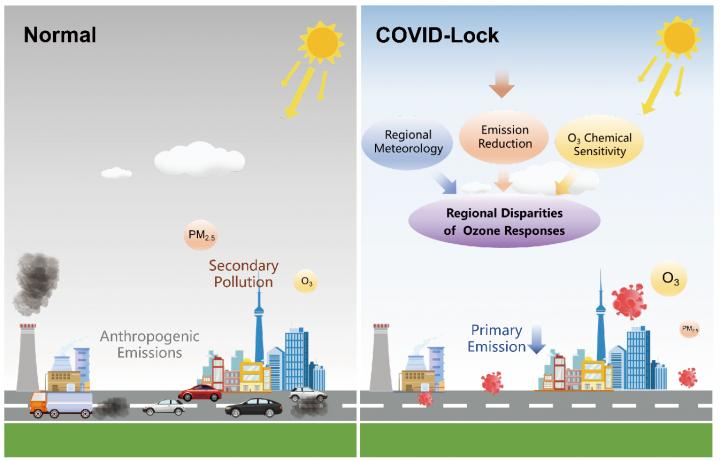
Credit: TANG Rong
The outbreak of COVID-19 raised a question about the relationship between anthropogenic emissions and air pollution, which has aroused heated discussion. Research on air-quality changes caused by the lockdowns in different areas shows similar substantial reductions in primary emissions. However, regional disparities exist in responses of secondary pollutants to emissions reduction, especially fine particulate matter and ozone (O3).
Professor Ding Aijun and his team from Nanjing University explored global air-quality changes during COVID-19 lockdowns and regional disparities in O3 responses to emission reductions. They integrated multiple observational datasets, including global air quality monitoring network and satellite retrievals, to shed more light on the regional differences in interactions between emissions, atmospheric chemistry, and meteorological conditions. Their findings were recently published in Atmospheric and Oceanic Science Letters.
“Observational signals of air-quality change were extracted from multi-year ground-based measurements and satellite-retrieved atmospheric composition columns. Ozone shows rising signals in most areas of both East Asia and Europe, whereas a non-negligible declining signal exists in North America, despite reductions in nitrogen oxides (NOx) over the three regions. This indicates significant differences in the relationships between NOx and O3 changes,” says by Prof. Ding.
Furthermore, Ding and his team investigated meteorological and atmospheric chemical drivers behind the different O3 responses based on data analysis and proxy indicators (HCHO/NO2) for diagnosing O3 photochemical sensitivity. They found that the responses of O3 to declines in NOx can to a certain extent be affected by the primary dependence on its precursors. The response of O3 in Europe fits particularly well with the O3 sensitivity regimes.
The study points out that meteorological factors–especially temperature–are rather important drivers of O3 responses. Apart from weakened titration effects caused by declines in NOx, increased O3 in East Asia and Europe tended to be largely dominated by the climatologically warmer temperatures during the lockdowns in 2020.
“Still, the contribution of rising temperature may have been partly offset by weakened photochemical reactions due to a decline in solar radiation and an increase in relative humidity in southern China and southern Europe. For North America, declines in temperature and substantial increases in humidity might have been important contributors to the decreased O3 over the western coasts,” concludes by Prof. Ding.
By investigating the impacts of meteorological conditions and chemical sensitivity under emission reductions, this research was able to emphasize the importance of regional disparities and combined effects of precursor reductions and meteorological influences in mitigating O3 pollution.
###
Media Contact
Ms. LIN Zheng
[email protected]
Related Journal Article
http://dx.




